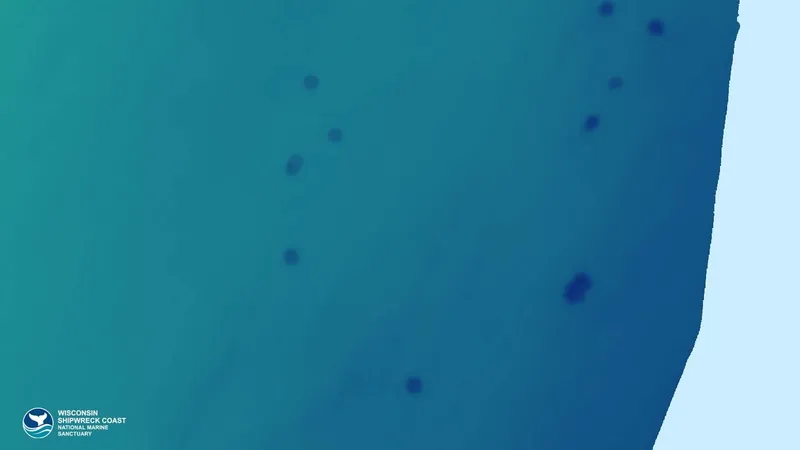
Astonishing Discovery: 40 Giant Craters Unearthed at the Depths of Lake Michigan!
2024-09-27
Astonishing Discovery: 40 Giant Craters Unearthed at the Depths of Lake Michigan!
In an extraordinary scientific revelation, researchers have confirmed the existence of 40 massive craters at the bottom of Lake Michigan. This discovery, which began two years ago when sonar scans unveiled strange circular formations, has sparked new intrigue and questions regarding what lies beneath the surface of this iconic lake.
The initial detection of these peculiar shapes took place in 2022 during a focused expedition aimed at mapping the lakebed within the Wisconsin Shipwreck Coast National Marine Sanctuary. This protected area not only safeguards 36 known shipwrecks but potentially many more mysteries of the deep. Russ Green, a maritime archaeologist involved in the mapping project, expressed excitement about the discovery. "Any kind of new finding in the Great Lakes is thrilling, especially since these features had never been documented before in such deep waters, approximately 500 feet (150 meters) deep," Green shared.
Local shipwreck hunter Brendon Baillod also noticed these enigmatic circles while on the lookout for a sunken freighter. To him, it was evident that the formations were craters measuring between 20 and 40 feet (6 to 12 meters) deep. "We counted numerous depressions during our search," Baillod mentioned, with most ranging from 500 to 1,000 feet (150 to 300 meters) in diameter and exhibiting irregular shapes.
After a delay in processing the data from the initial mapping, a collaboration was initiated between Green, Baillod, and scientists from the National Oceanic and Atmospheric Administration's (NOAA) Great Lakes Environmental Research Laboratory (GLERL). Their combined efforts included a focused survey on August 21, during which a remotely operated vehicle confirmed that these shapes are indeed substantial, naturally-occurring craters.
Researcher Steve Ruberg described these craters as "perfect, little circles" situated approximately 14 miles (23 kilometers) southeast of Sheboygan, Wisconsin. The formations extend in a southward line toward Port Washington, further encouraging investigation into their origins.
Interestingly, similar depressions have previously been identified at the bottom of Lake Huron, bordering Michigan and Canada. Those formations were found to be sinkholes, which form when groundwater erodes the bedrock, resulting in the collapse of the surface. Given that Lake Michigan rests atop limestone—highly susceptible to dissolution—it's thought that the craters here could also be sinkholes, although further research is necessary to confirm this assertion.
While some experts suggest that these formations may be more accurately classified as craters, arising potentially from water upwelling or trapped gas emissions, others remain cautious in their conclusions. Baillod indicated that until additional research is conducted, definitive labeling as sinkholes may be premature.
The recent survey did not reveal any signs of water escape from the craters, which would typically indicate groundwater flow below. Nevertheless, Ruberg expressed anticipation that future explorations will uncover such dynamics. Observations from video footage displayed an underwater ecosystem teeming with life, including freshwater shrimp, small fish, and invasive quagga mussels thriving in these dark aquatic realms.
The broader ecological impact of these craters on Lake Michigan remains uncertain, but researchers are eager to delve deeper into their implications. “We’ll continue exploring these fascinating formations in the years to come, striving to understand how they came to be and what role they play in the ecosystem of Lake Michigan,” affirmed Green.
As the scientific community gears up for ongoing research, one thing is clear: the depths of Lake Michigan may hold even more secrets waiting to be uncovered!



 Brasil (PT)
Brasil (PT)
 Canada (EN)
Canada (EN)
 Chile (ES)
Chile (ES)
 España (ES)
España (ES)
 France (FR)
France (FR)
 Hong Kong (EN)
Hong Kong (EN)
 Italia (IT)
Italia (IT)
 日本 (JA)
日本 (JA)
 Magyarország (HU)
Magyarország (HU)
 Norge (NO)
Norge (NO)
 Polska (PL)
Polska (PL)
 Schweiz (DE)
Schweiz (DE)
 Singapore (EN)
Singapore (EN)
 Sverige (SV)
Sverige (SV)
 Suomi (FI)
Suomi (FI)
 Türkiye (TR)
Türkiye (TR)